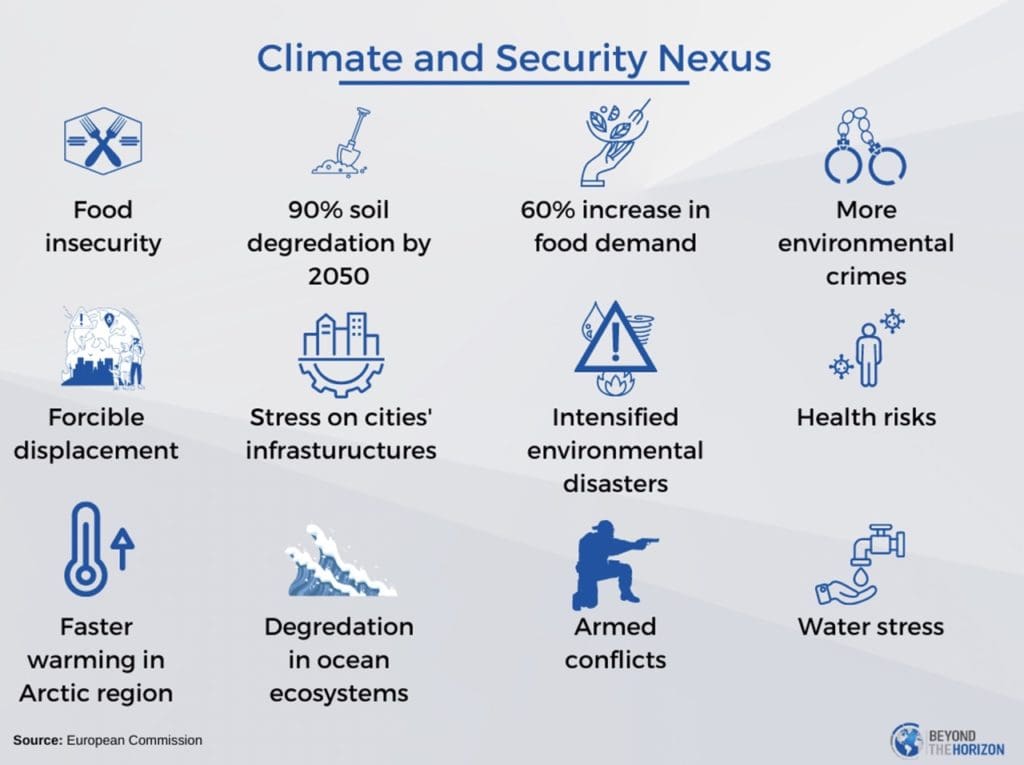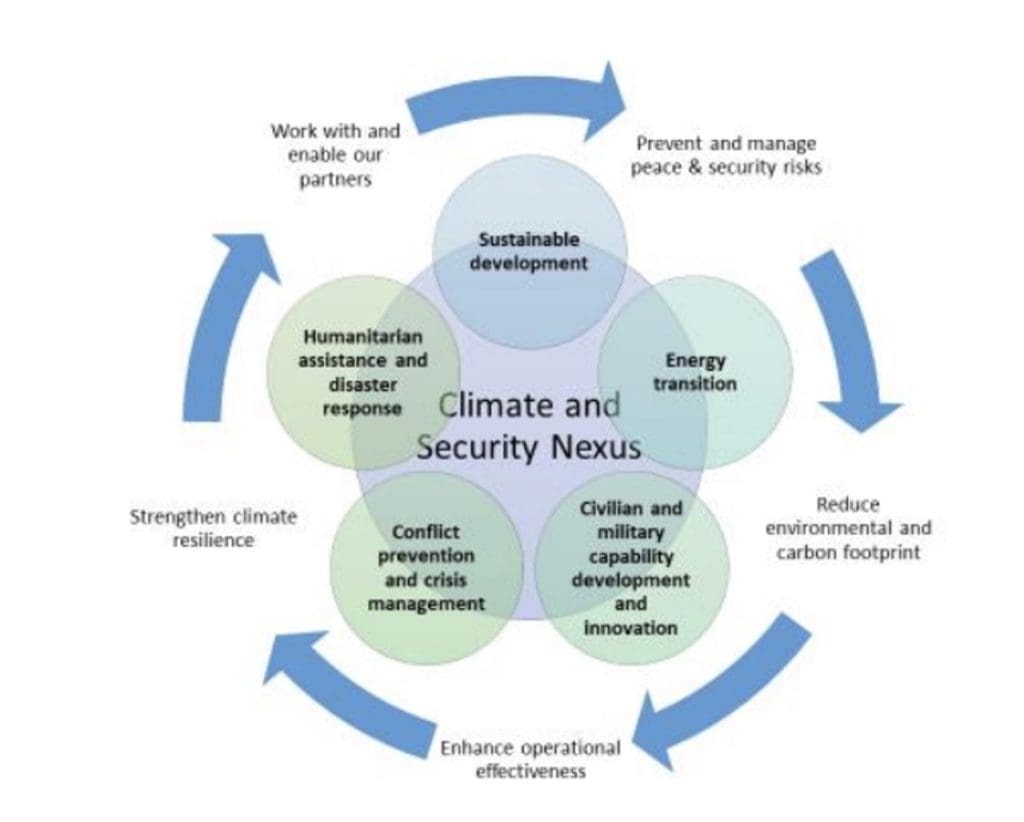The risks posed by climate change, such as extreme weather events and losses in biodiversity, have forced security policy-makers to change their traditional security paradigms that mostly rely on power struggles among major powers. More than one billion people are expected to have difficulty at reaching water by the year 2050. Reduced food production, rising sea levels, floods and heatwaves are strong indications of more mass migration and intensified armed conflicts. European Commission has released a new document named “A new outlook on the climate change and security nexus” to develop a new security paradigm in harmony with the emerging climate risks.

Figure-1 Climate and Security Nexus (Source: EU Commission)
What are the aims that the EU pursue?
In short, the EU aims at preventing and mitigating spillover effects on its territory. After the Arab Spring, mass migration from the MENA region to the EU has increased due to the security problems such as the war in Syria and armed conflicts in North Africa. Climate change has exacerbated those security problems. According to the UN, 12 of the 20 least prepared countries for the negative impacts of climate change have suffered from armed conflicts in 2020. This translates into greater EU vulnerability to future mass migration movements.

Figure-2 The State of Global Peace in 2023 (Source: Statista)
In line with the similar efforts of NATO, the EU wants to integrate the relationship between security and climate risks in its security and foreign policies, including Common Security and Defence Policy (CSDP). The European Green Deal has created significant geopolitical implications in the EU’s relationship with its international partners. The EU will adopt a similar approach in defining its security policies that foster new partnerships with other countries and regions in dealing with climate change-related security problems.

Figure-3 The Interrelation of Different Actions in the Context of Climate and Security Nexus (Source: European Commission)
What are the ingredients of the new security paradigm?
The decision-making and planning processes of security policies must be based on scientific findings about climate risks. Furthermore, climate mitigation and adaptation measures should be included in the civilian and military capabilities of the EU members. The EU is aware of the need to build an international coalition with like-minded partners to mitigate the negative impacts of climate change on its security.
The role of data and analytics in the assessment of climate risks
Early warning and conflict analyses facilitate the identification of potential environmental security risks. Against this backdrop, the European Union Satellite Centre (SatCen) will build “The Climate and Environmental Security Data and Analysis Hub” that aims at enhancing the quality of EEAS’s annual comprehensive trend analysis and improving the performance of current platforms such as the Science for Peace Portal. The other EU initiatives for using data and analysis to detect climate and environmental-related risks are;
- Copernicus’ Emergency Management Service
- INFORM
- European Marine Observation and Data Network (EMODnet)
- Destination Earth initiative
Collective actions on a global scale are needed to limit the damages of climate risks. Otherwise, all nations will be subject to climate-related security risks. In this regard, the EU plans to accelerate the establishment of regional collaborations in “global initiatives for evidence-based decision-making”. The collection of data from the armed forces of EU members via the European Defence Agency is planned to strengthen climate-related defence investments. Horizon Europe (2021-2027), as the EU research and innovation framework program, plays a critical role in boosting the EU’s climate-related data gathering and analysis capacity.
Integration of climate policies in EU foreign policy
The decision-makers in the EU are aware that the effectiveness of climate policies depends on their interrelation with the foreign and security policies of the EU. Supporting the vulnerable countries to the negative impacts of climate change to mitigate food insecurity and strengthen the climate adaptation capacities of those countries will indirectly reduce the climate-related security problems that the EU have to deal with. 30% of the spending in the context of NDCI-Global Europe is targeted to support climate mitigation and adaptation policies in different countries.
Peacebuilding initiatives are a cornerstone in the EU-integrated approach in order to deal with escalating impacts of insufficient resources and weak governance in tackling climate risks in vulnerable countries. “Transboundary cooperation on water” is a good example of peacebuilding initiatives for conflict prevention.
Humanitarian intervention is another tool for security policymakers to alleviate the suffering of people caused by environmental degradation. The level of civil-military cooperation is crucial to enhance risk prevention and mitigation capacity. EU humanitarian aid and the Union Civil Protection Mechanism and Disaster Preparedness Budget Line are the instruments of the EU to support humanitarian intervention operations.
Building effective crisis management practices in line with the “EU Common Security and Defence Policy (CSDP)” and the “Strategic Compass”, such as having an environmental adviser and reporting environmental footprint, are expected to increase the EU’s capacity to respond to climate emergencies.
Conclusion
Heatwaves, floods, droughts and climate-related risks have become more conspicuous and created unconventional security threats that may affect billions of people in the near future. Traditional security paradigm does not provide effective security tools that are required to prevent and mitigate those risks. As a global leader in climate policies, the EU’s effort to strengthen the links between security and climate policies is the right step in promoting the establishment of a new common security framework that is based on global cooperation.
Having said that, the fracture in international security and foreign policy institutions such as the United Nations Security Council has deepened in the wake of the Ukraine war. Therefore, the effectiveness of the multilateral efforts is not sufficient to enable the establishment of a global security pact that aims at countering the needs of vulnerable countries in the face of climate-related security risks.

